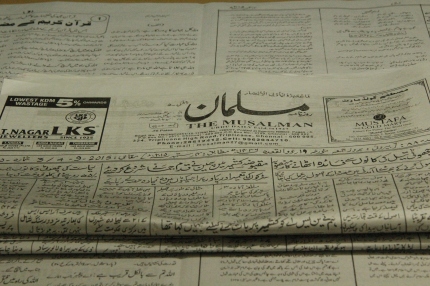Chennai: As internet users across the world began to expand, every media house woke up to the need of having an online presence. The advent of new media led to the birth of immersive journalism and the future of traditional media became a subject of serious discussions. Amidst this debate, a small printing press in Chennai remained unperturbed.

Located in Pachaiyappan Street, this printing press has been publishing a newspaper called The Musalman, since 1927. Credited as the first Urdu newspaper of the country, today The Musalman is the last handwritten newspaper in the world.
At first glance, nobody can identify the office as a site for “serious” journalism. Equipped with the most modest facilities, the space does not have the tools associated with a conventional newsroom. A single computer and a fax machine are installed in one corner and the rest of the space is dedicated to Katibs, trained in the art of calligraphy, who literally write headlines everyday.


Khurshid begum and Tajuma begum are the two calligraphers involved with The Musalman since adulthood. Their hands create magic on paper with bold, beautiful strokes. The process of writing couldn’t be more elegant and the sound of the reed quills against the paper is enchanting.
Everyday, the two women sit at their table for six hours continuously and each of them works on two different pages. It takes them approximately 3 hours to finish one side of a paper. Their skills and patience cannot be quantified as even a single mistake can result in them having to rewrite the entire page.
The Musalman was founded by Syed Azmathullah to be the voice of Muslims in the South. During the time of independence, when divisive politics was at its height, the newspaper maintained its secular stand and promoted unity by employing the services of a Hindu chief reporter. Even today, that trend remains unchanged. The Musalman’s chief reporter, Chinnaswami Balasubaraniam, is a Hindu and has been involved with the newspaper for the past twenty years.
It was his love for the Urdu language, which made him join the newspaper under the editorship of Syed Fazullah. He has seen the publication go through several ups and downs. In his words, “Mr. Fazullah’s death in 2008 was one of the most difficult times for The Musalman. His son, Syed Arifullah took over the reins of management and the team began to work together to preserve a legacy.”
Mr. Arif’s decision to register the newspaper with DAVP provided the much-needed financial support to the publication as it started receiving more advertisements than before. According to RNI, the newspaper has a circulation of 22,000.
Published as a broadsheet, The Musalman employs the services of translators and has reporters in the cities of Kolkata, Lucknow and New Delhi. The bond that these employees share with the newspaper is commendable. They are all working towards a common goal and are driven by the same motivation.
Translator Ahmad-Uddin was forced to quit work because of his old age and ill-health. However, his enthusiasm when he hears the name of The Musalman shines through. He still wants to translate for the newspaper if an arrangement can be made for him to work from home.
The Musalman is the remnants of a bygone era. It is not possible to say how much longer it will survive. However, it cannot be denied that the uniqueness of the newspaper and dedication of its workforce make for a wonderful combination.
Video courtesy: Indian Diplomacy, Youtube
